A Compact Dual-Band Millimeter Wave Antenna for Smartwatch and IoT Applications with Link Budget Estimation
Abstract
:1. Introduction
- the design and development of a compact dual-band antenna with the aid of characteristic mode theory to comprehend the resonant modes and their resultant radiation pattern;
- an analysis of the performance of the proposed antenna for smartwatch applications by embedding it inside the watch case;
- a study of the RF energy exposure to the human body caused by the proposed antenna with a watch case;
- an estimation of the data handling capacity of the proposed antenna for a smartwatch at various angles in three-dimensional space.
2. Characteristic Mode-Based Antenna Methodology
3. Current Distribution with Port Excitation
4. Parametric Analysis of Antenna Elliptical Structure
5. Results and Discussion
5.1. Reflection Coefficients and Radiation Patterns in Free Space
5.2. Antenna Performance with Watch Case
5.3. SAR Analysis
5.4. Link Budget Analysis
5.5. Comparative Analysis
6. Future Scope
7. Conclusions
Author Contributions
Funding
Institutional Review Board Statement
Informed Consent Statement
Data Availability Statement
Conflicts of Interest
References
- Chandel, R.S.; Sharma, S.; Kaur, S.; Singh, S.; Kumar, R. Smart Watches: A Review of Evolution in Bio-Medical Sector. Mater. Today Proc. 2022, 50, 1053–1066. [Google Scholar] [CrossRef]
- Global: Smartwatches Number of Users 2018–2027. Available online: https://www.statista.com/forecasts/1314339/worldwide-users-of-smartwatches (accessed on 11 November 2023).
- Hao, T.; Bi, C.; Xing, G.; Chan, R.; Tu, L. MindfulWatch: A Smartwatch-Based System for Real-Time Respiration Monitoring During Meditation. Proc. ACM Interact. Mob. Wearable Ubiquitous Technol. 2017, 1, 1–19. [Google Scholar] [CrossRef]
- Xintarakou, A.; Sousonis, V.; Asvestas, D.; Vardas, P.E.; Tzeis, S. Remote Cardiac Rhythm Monitoring in the Era of Smart Wearables: Present Assets and Future Perspectives. Front. Cardiovasc. Med. 2022, 9, 853614. [Google Scholar] [CrossRef] [PubMed]
- Kwon, J.; Jo, Y.-Y.; Lee, S.Y.; Kang, S.; Lim, S.-Y.; Lee, M.S.; Kim, K.-H. Artificial Intelligence-Enhanced Smartwatch ECG for Heart Failure-Reduced Ejection Fraction Detection by Generating 12-Lead ECG. Diagnostics 2022, 12, 654. [Google Scholar] [CrossRef] [PubMed]
- He, J.; Ou, J.; He, A.; Shu, L.; Liu, T.; Qu, R.; Xu, X.; Chen, Z.; Yan, Y. A New Approach for Daily Life Blood-Pressure Estimation Using Smart Watch. Biomed. Signal Process. Control 2022, 75, 103616. [Google Scholar] [CrossRef]
- Xu, Z.; Wang, Y. Design of Dual-Band Antenna for Metal-Bezel Smartwatches with Circular Polarization in GPS Band and Low Wrist Effect. IEEE Trans. Antennas Propagat. 2023, 71, 4651–4662. [Google Scholar] [CrossRef]
- Liao, C.-T.; Yang, Z.-K.; Chen, H.-M. Multiple Integrated Antennas for Wearable Fifth-Generation Communication and Internet of Things Applications. IEEE Access 2021, 9, 120328–120346. [Google Scholar] [CrossRef]
- Xiao, B.; Wong, H.; Wu, D.; Yeung, K.L. Design of Small Multiband Full-Screen Smartwatch Antenna for IoT Applications. IEEE Internet Things J. 2021, 8, 17724–17733. [Google Scholar] [CrossRef]
- Mallat, N.K.; Ishtiaq, M.; Ur Rehman, A.; Iqbal, A. Millimeter-Wave in the Face of 5G Communication Potential Applications. IETE J. Res. 2022, 68, 2522–2530. [Google Scholar] [CrossRef]
- Ahmad, S.; Boubakar, H.; Naseer, S.; Alim, M.E.; Sheikh, Y.A.; Ghaffar, A.; Al-Gburi, A.J.A.; Parchin, N.O. Design of a Tri-Band Wearable Antenna for Millimeter-Wave 5G Applications. Sensors 2022, 22, 8012. [Google Scholar] [CrossRef]
- Ruchi; Patnaik, A.; Kartikeyan, M.V. Compact Dual and Triple Band Antennas for 5G-IOT Applications. Int. J. Microw. Wirel. Technol. 2022, 14, 115–122. [Google Scholar] [CrossRef]
- Garbacz, R.; Turpin, R. A Generalized Expansion for Radiated and Scattered Fields. IEEE Trans. Antennas Propagat. 1971, 19, 348–358. [Google Scholar] [CrossRef]
- Yee, A.; Garbacz, R. Self-and Mutual-Admittances of Wire Antennas in Terms of Characteristic Modes. IEEE Trans. Antennas Propagat. 1973, 21, 868–871. [Google Scholar] [CrossRef]
- Kim, G.; Kim, S. Design and Analysis of Dual Polarized Broadband Microstrip Patch Antenna for 5G mmWave Antenna Module on FR4 Substrate. IEEE Access 2021, 9, 64306–64316. [Google Scholar] [CrossRef]
- Adams, J.J.; Genovesi, S.; Yang, B.; Antonino-Daviu, E. Antenna Element Design Using Characteristic Mode Analysis: Insights and Research Directions. IEEE Antennas Propag. Mag. 2022, 64, 32–40. [Google Scholar] [CrossRef]
- Gao, G.; Zhang, R.-F.; Geng, W.-F.; Meng, H.-J.; Hu, B. Characteristic Mode Analysis of a Nonuniform Metasurface Antenna for Wearable Applications. Antennas Wirel. Propag. Lett. 2020, 19, 1355–1359. [Google Scholar] [CrossRef]
- Li, H.; Tan, Y.; Lau, B.K.; Ying, Z.; He, S. Characteristic Mode Based Tradeoff Analysis of Antenna-Chassis Interactions for Multiple Antenna Terminals. IEEE Trans. Antennas Propagat. 2012, 60, 490–502. [Google Scholar] [CrossRef]
- Mohanty, A.; Behera, B.R. Characteristics Mode Analysis: A Review of Its Concepts, Recent Trends, State-Of-The-Art Developments and Its Interpretation with A Fractal UWB MIMO Antenna. Prog. Electromagn. Res. B 2021, 92, 19–45. [Google Scholar] [CrossRef]
- Balanis, C.A. Antenna Theory: Analysis and Design, 4th ed.; John Wiley & Sons: Hoboken, NJ, USA, 2016; ISBN 978-1-118-64206-1. [Google Scholar]
- Ukkonen, L.; Sydanheimo, L.; Kivikoski, M. Effects of Metallic Plate Size on the Performance of Microstrip Patch-Type Tag Antennas for Passive RFID. Antennas Wirel. Propag. Lett. 2005, 4, 410–413. [Google Scholar] [CrossRef]
- Klionovski, K.; Shamim, A. Back Radiation Suppression Through a Semitransparent Ground Plane for a Millimeter-Wave Patch Antenna. IEEE Trans. Antennas Propagat. 2017, 65, 3935–3941. [Google Scholar] [CrossRef]
- Redmayne, M.; Maisch, D.R. ICNIRP Guidelines’ Exposure Assessment Method for 5G Millimetre Wave Radiation May Trigger Adverse Effects. Int. J. Environ. Res. Public Health 2023, 20, 5267. [Google Scholar] [CrossRef] [PubMed]
- Taguchi, K.; Kodera, S.; Hirata, A.; Kashiwa, T. Computation of Absorbed Power Densities in High-Resolution Head Models by Considering Skin Thickness in Quasi-Millimeter and Millimeter Wave Bands. IEEE J. Electromagn. RF Microw. Med. Biol. 2022, 6, 516–523. [Google Scholar] [CrossRef]
- IT’IS Foundation. TISSUE DB. Database at a Glance. Available online: https://itis.swiss/virtual-population/tissue-properties/database/ (accessed on 4 April 2023).
- Bommisetty, L.; Pawar, S.; Venkatesh, T.G. Performance Analysis of Random Access Mechanism in 5G Millimeter Wave Networks: Effect of Blockage, Shadowing and Mobility. IEEE Access 2022, 10, 69091–69105. [Google Scholar] [CrossRef]
- Shariff, B.G.P.; Naik, A.A.; Ali, T.; Mane, P.R.; David, R.M.; Pathan, S.; Anguera, J. High-Isolation Wide-Band Four-Element MIMO Antenna Covering Ka-Band for 5G Wireless Applications. IEEE Access 2023, 11, 123030–123046. [Google Scholar] [CrossRef]
- Iqbal, A.; Al-Hasan, M.; Mabrouk, I.B.; Nedil, M. A Compact Implantable MIMO Antenna for High-Data-Rate Biotelemetry Applications. IEEE Trans. Antennas Propagat. 2022, 70, 631–640. [Google Scholar] [CrossRef]
- Munir, M.E.; Al Harbi, A.G.; Kiani, S.H.; Marey, M.; Parchin, N.O.; Khan, J.; Mostafa, H.; Iqbal, J.; Khan, M.A.; See, C.H.; et al. A New Mm-Wave Antenna Array with Wideband Characteristics for Next Generation Communication Systems. Electronics 2022, 11, 1560. [Google Scholar] [CrossRef]
- Mneesy, T.S.; Hamad, R.K.; Zaki, A.I.; Ali, W.A.E. A Novel High Gain Monopole Antenna Array for 60 GHz Millimeter-Wave Communications. Appl. Sci. 2020, 10, 4546. [Google Scholar] [CrossRef]
- Ali Esmail, B.; Koziel, S. High Isolation Metamaterial-Based Dual-Band MIMO Antenna for 5G Millimeter-Wave Applications. AEU Int. J. Electron. Commun. 2023, 158, 154470. [Google Scholar] [CrossRef]
- Khan, J.; Ullah, S.; Ali, U.; Tahir, F.A.; Peter, I.; Matekovits, L. Design of a Millimeter-Wave MIMO Antenna Array for 5G Communication Terminals. Sensors 2022, 22, 2768. [Google Scholar] [CrossRef]
- Munir, M.E.; Kiani, S.H.; Savci, H.S.; Marey, M.; Khan, J.; Mostafa, H.; Parchin, N.O. A Four Element Mm-Wave MIMO Antenna System with Wide-Band and High Isolation Characteristics for 5G Applications. Micromachines 2023, 14, 776. [Google Scholar] [CrossRef]

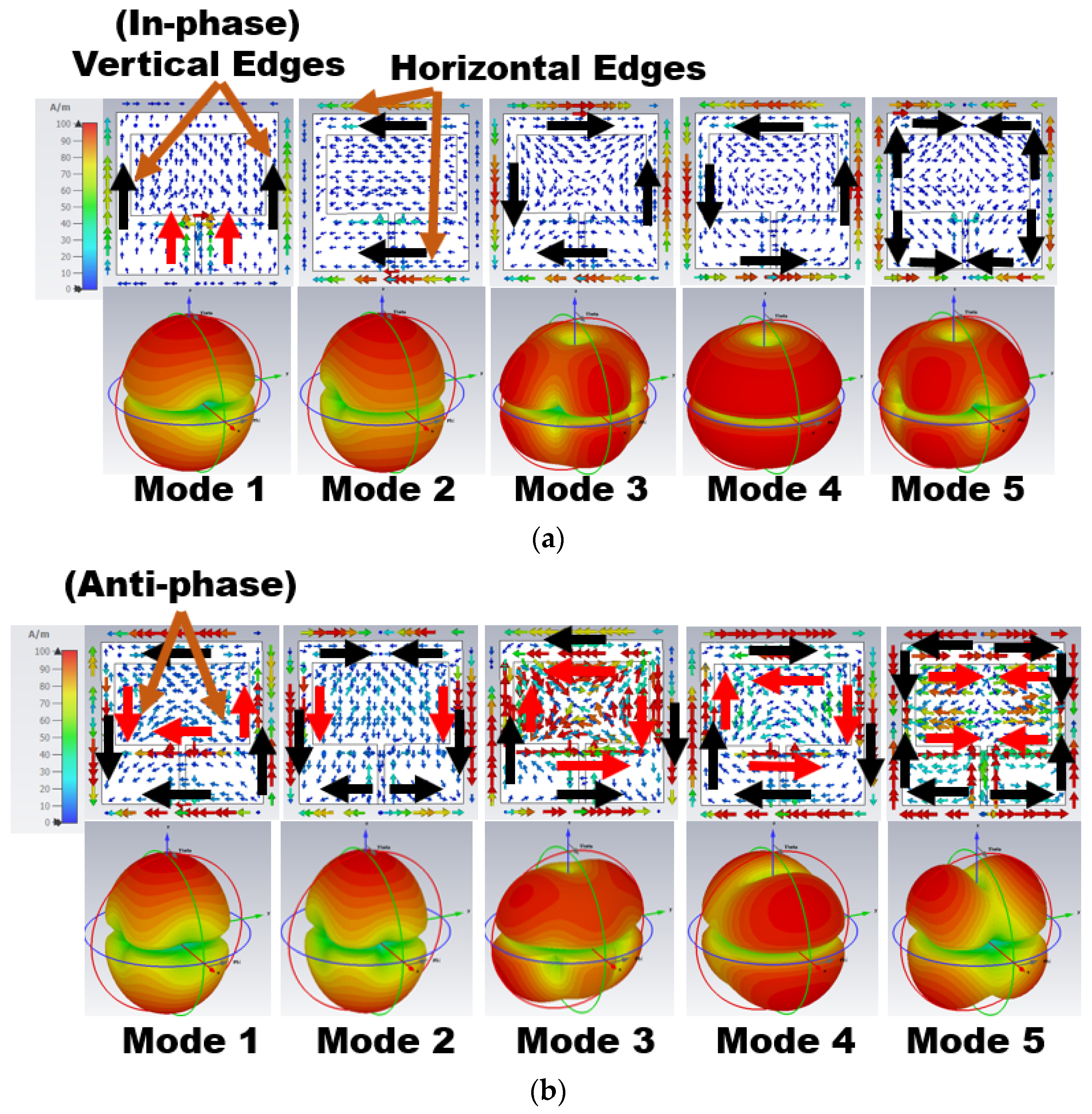
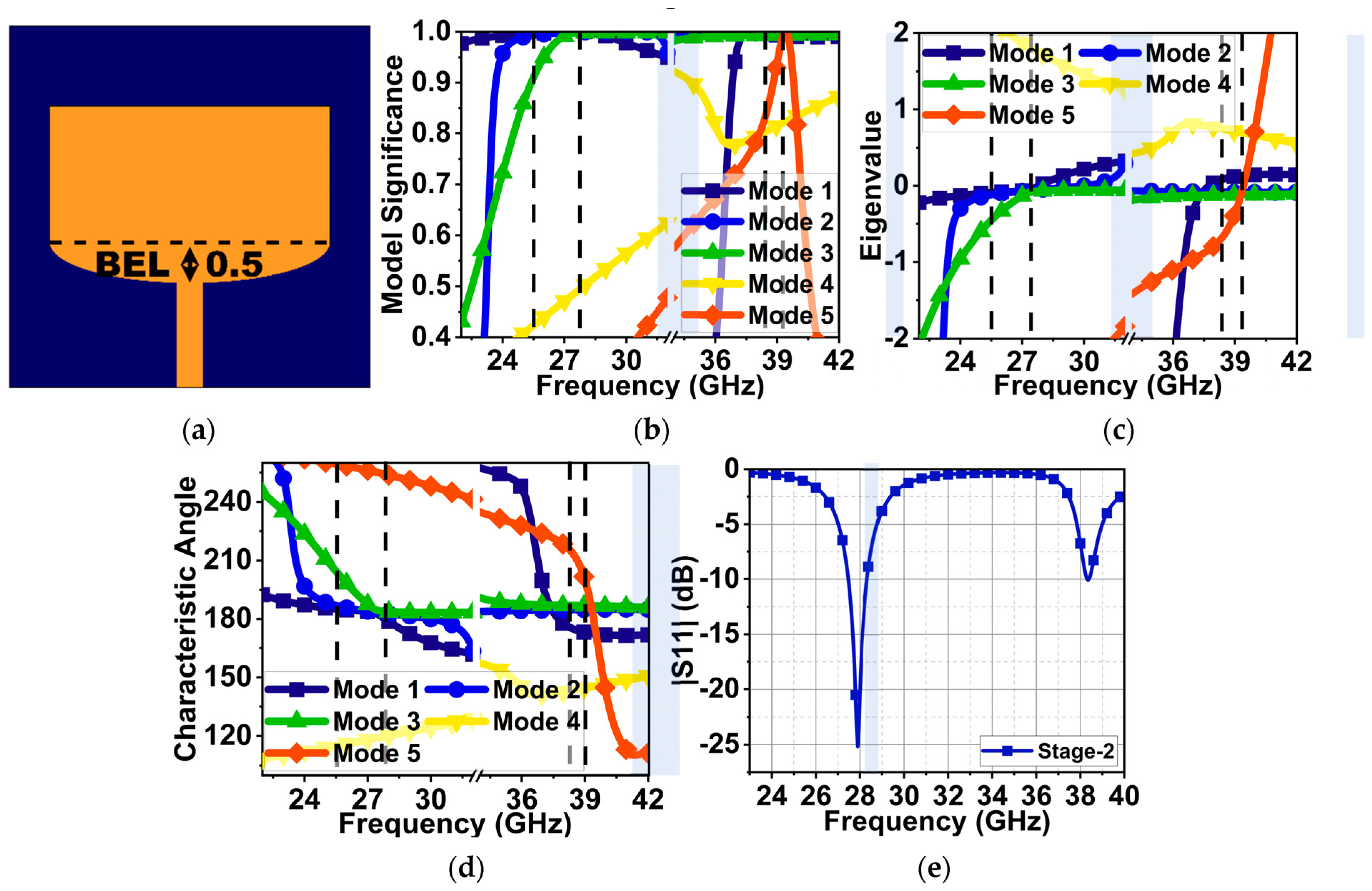



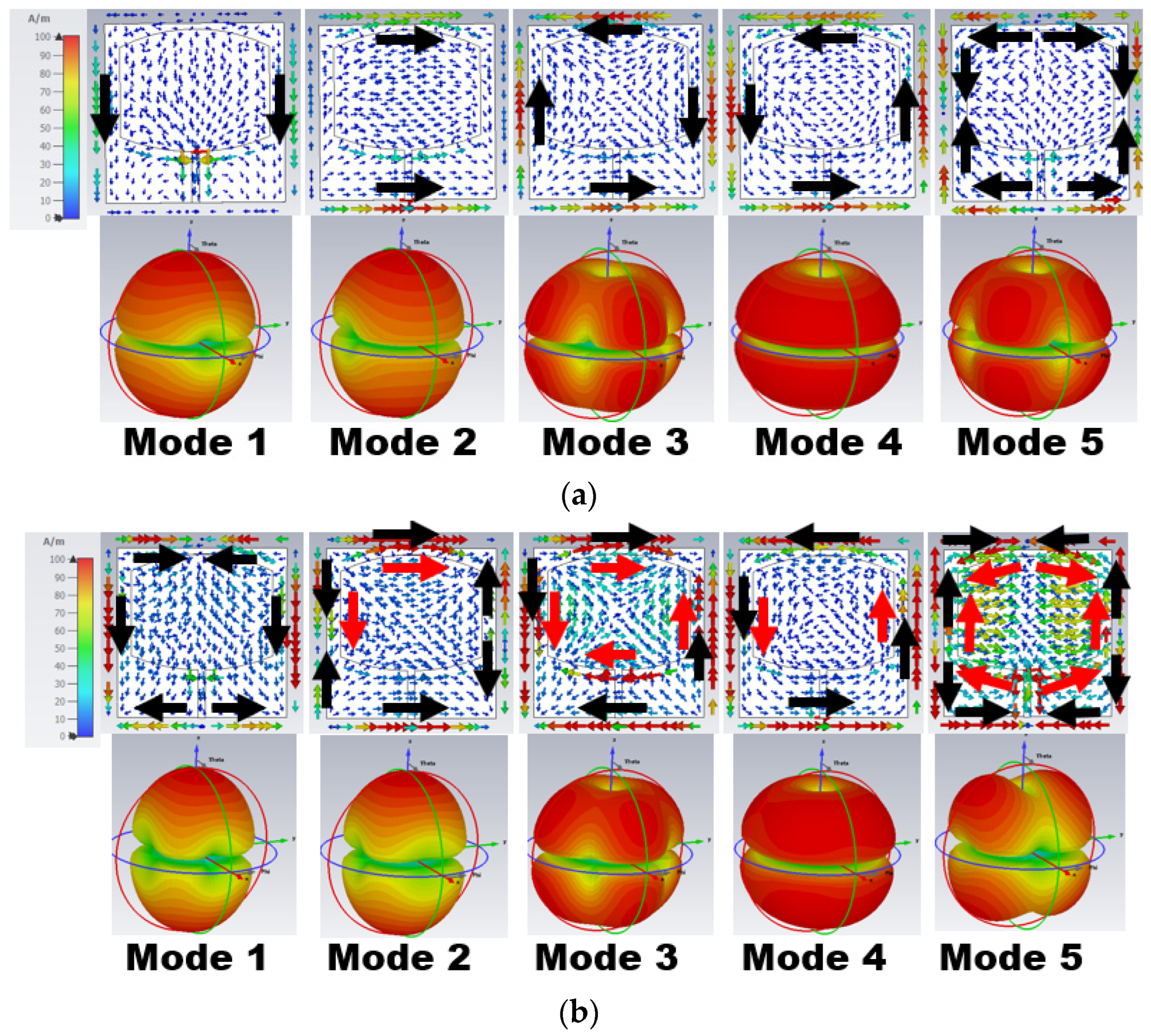



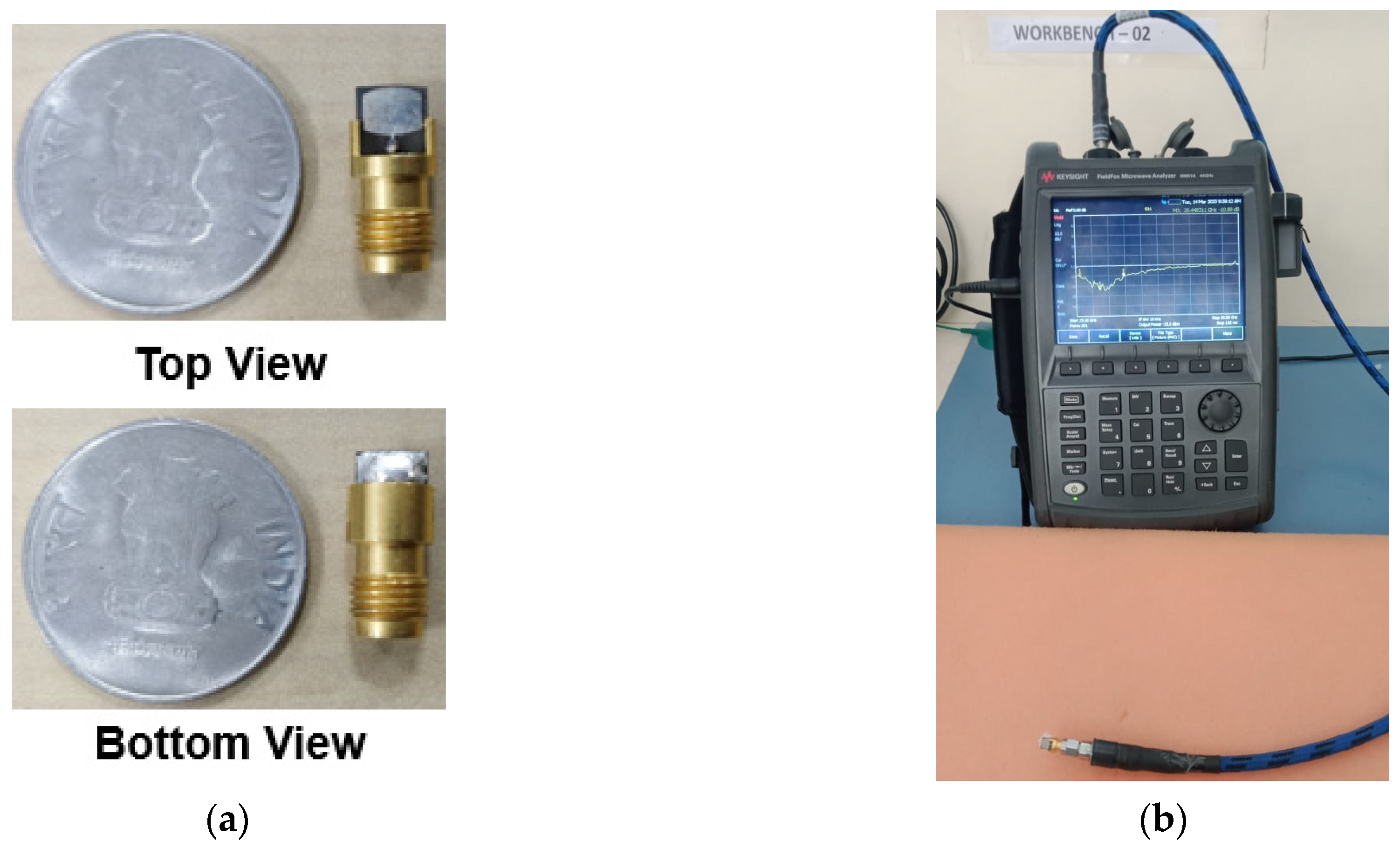
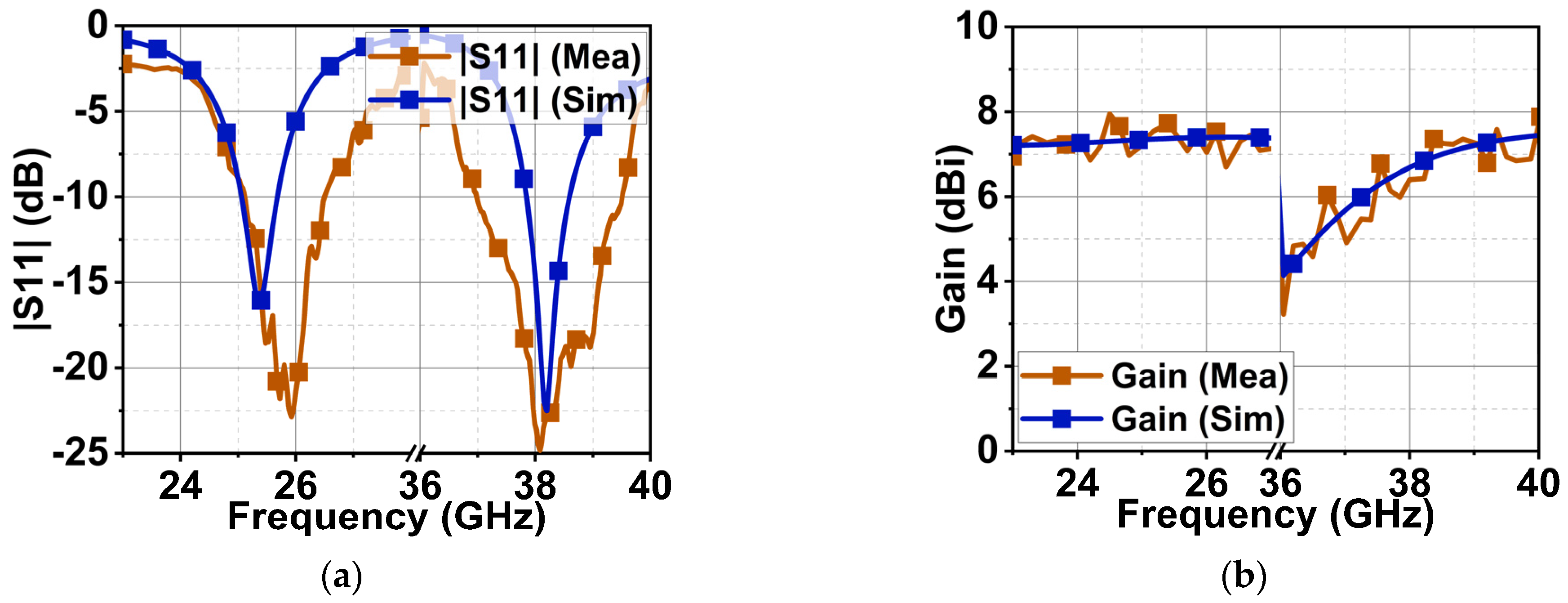
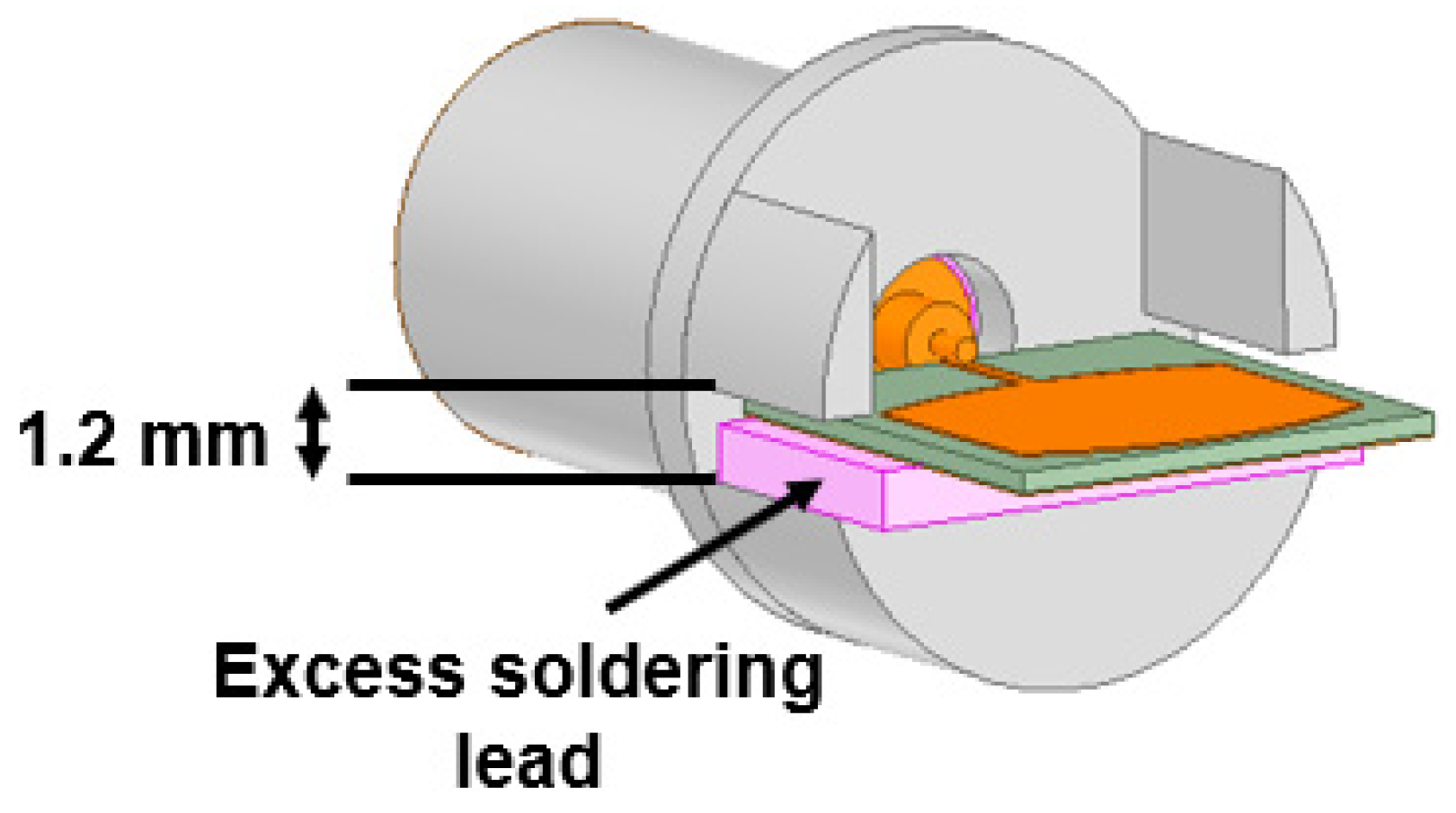

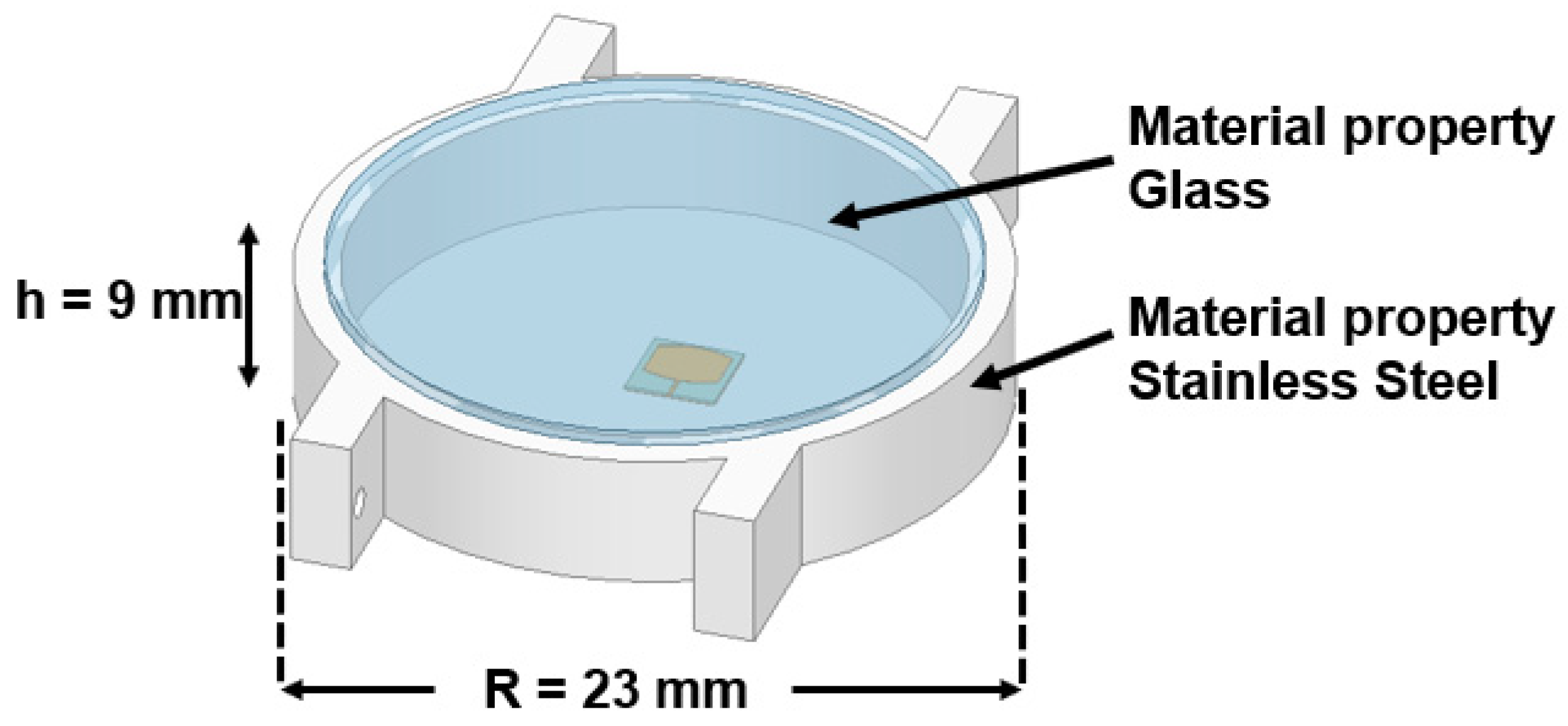
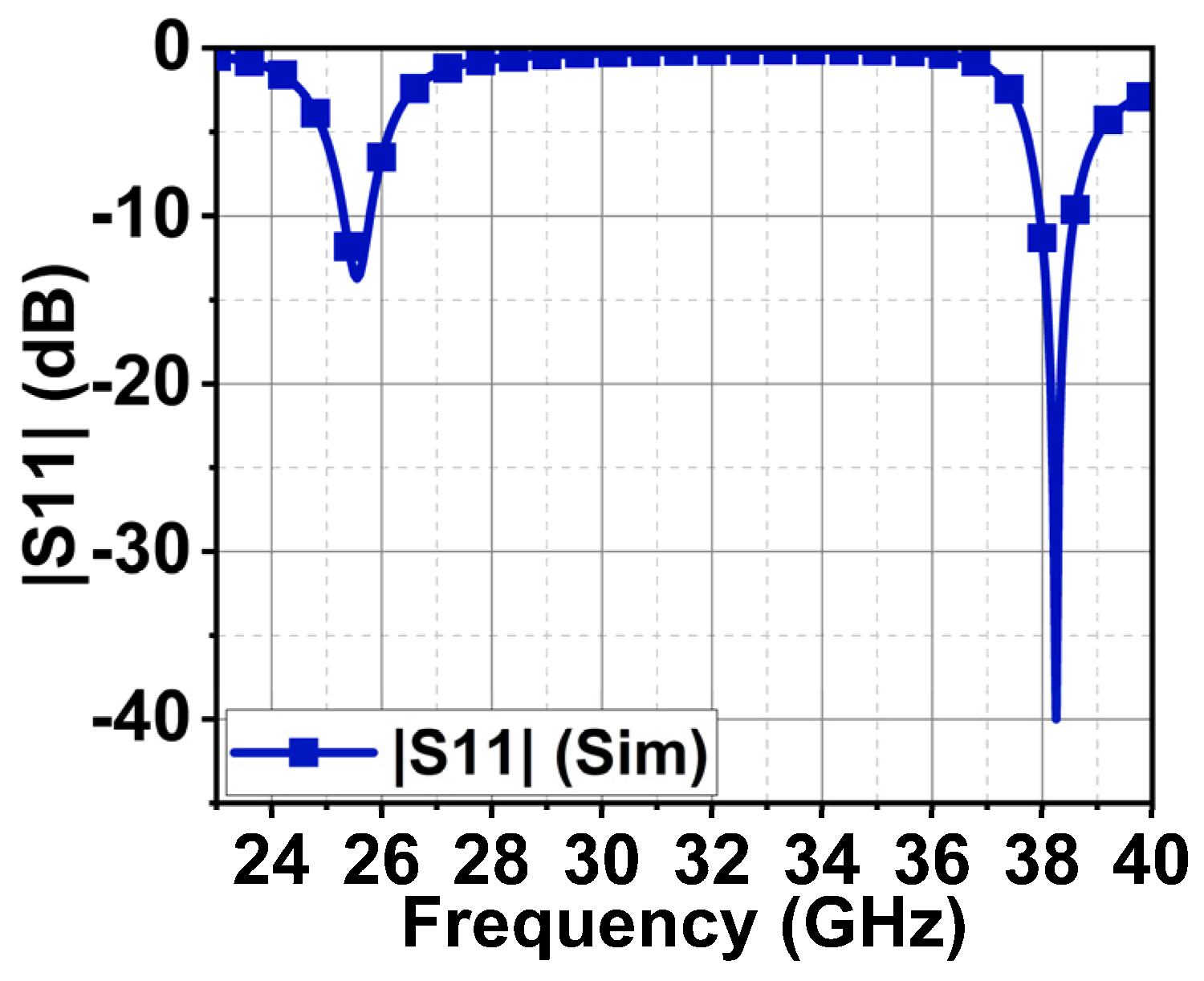
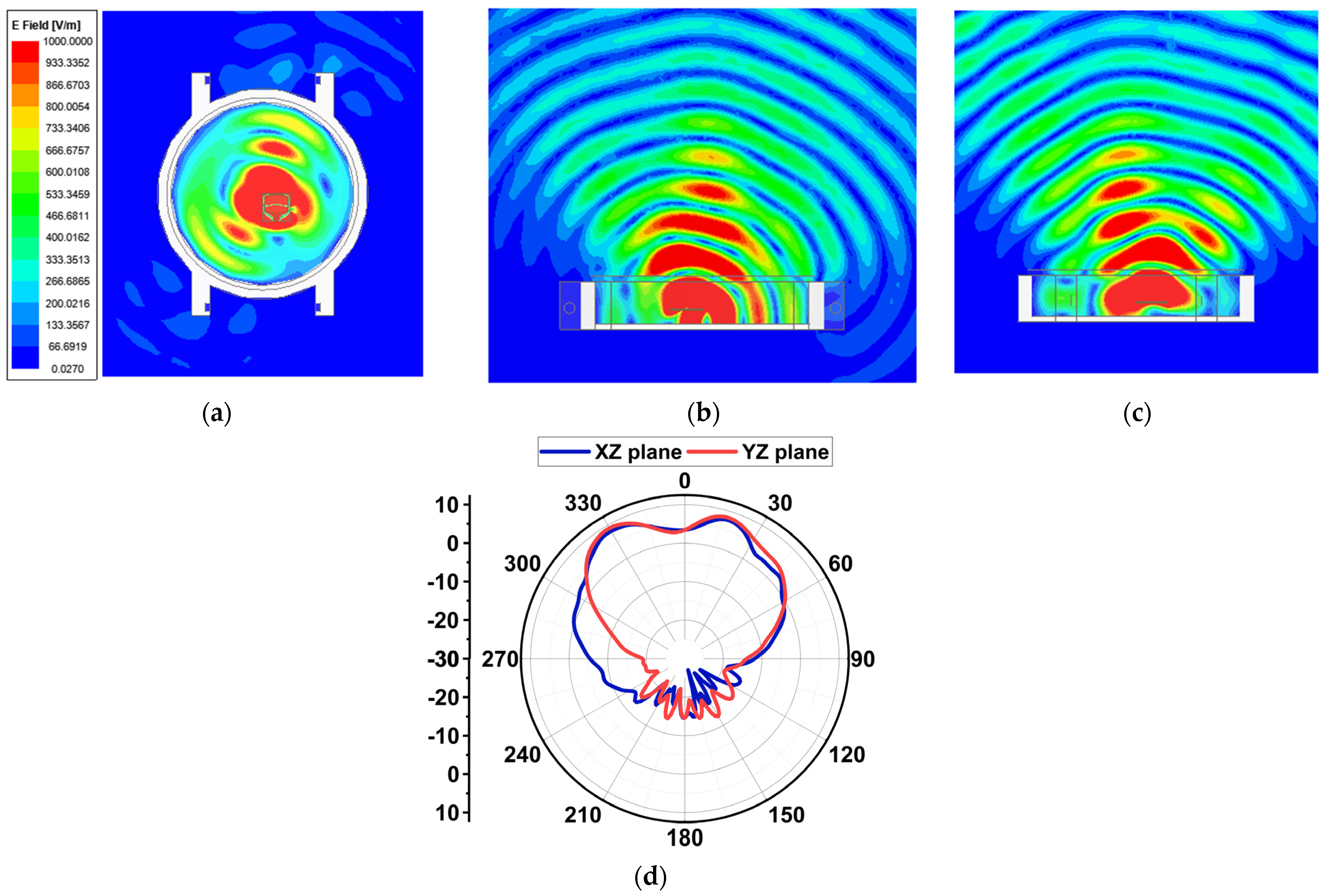
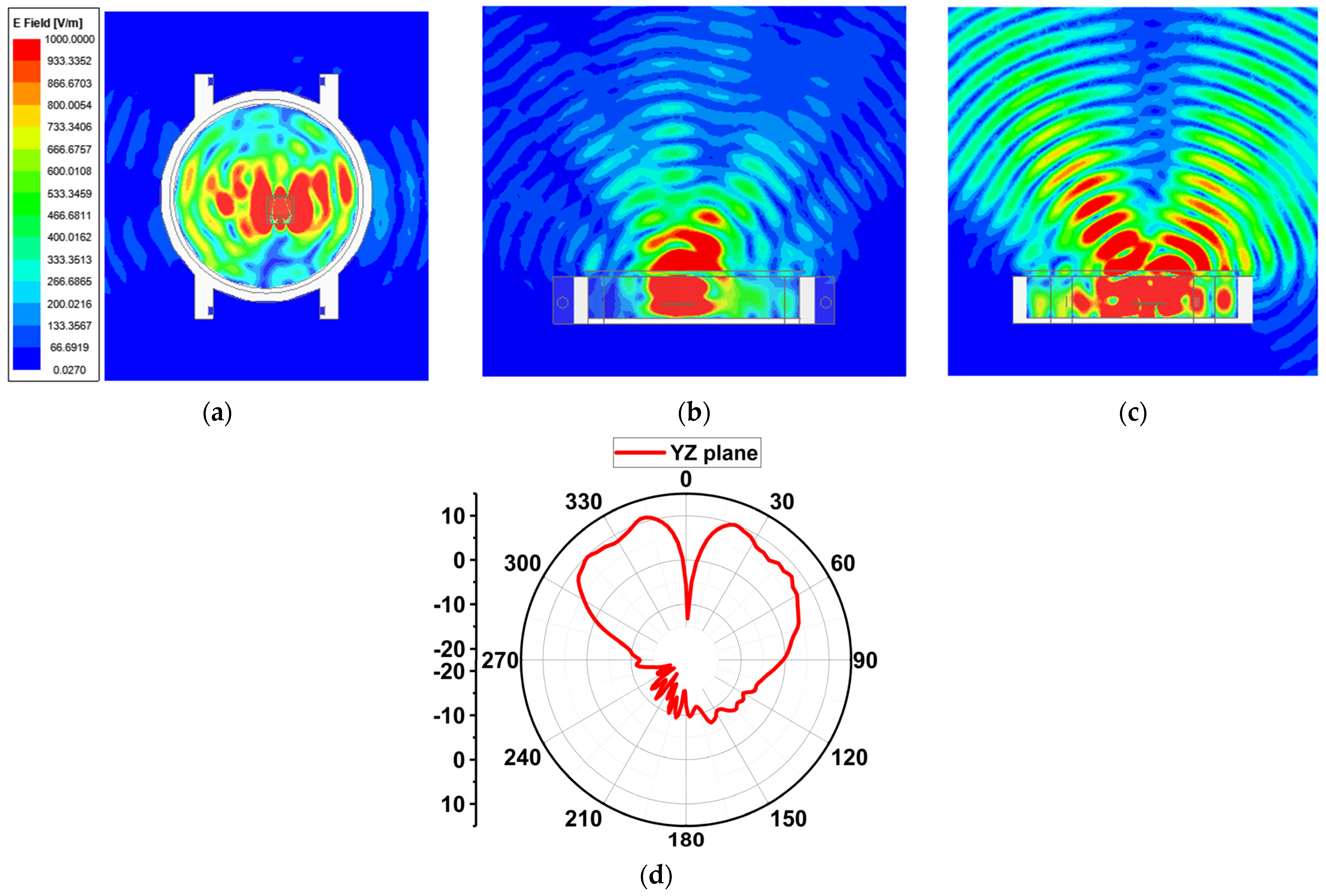
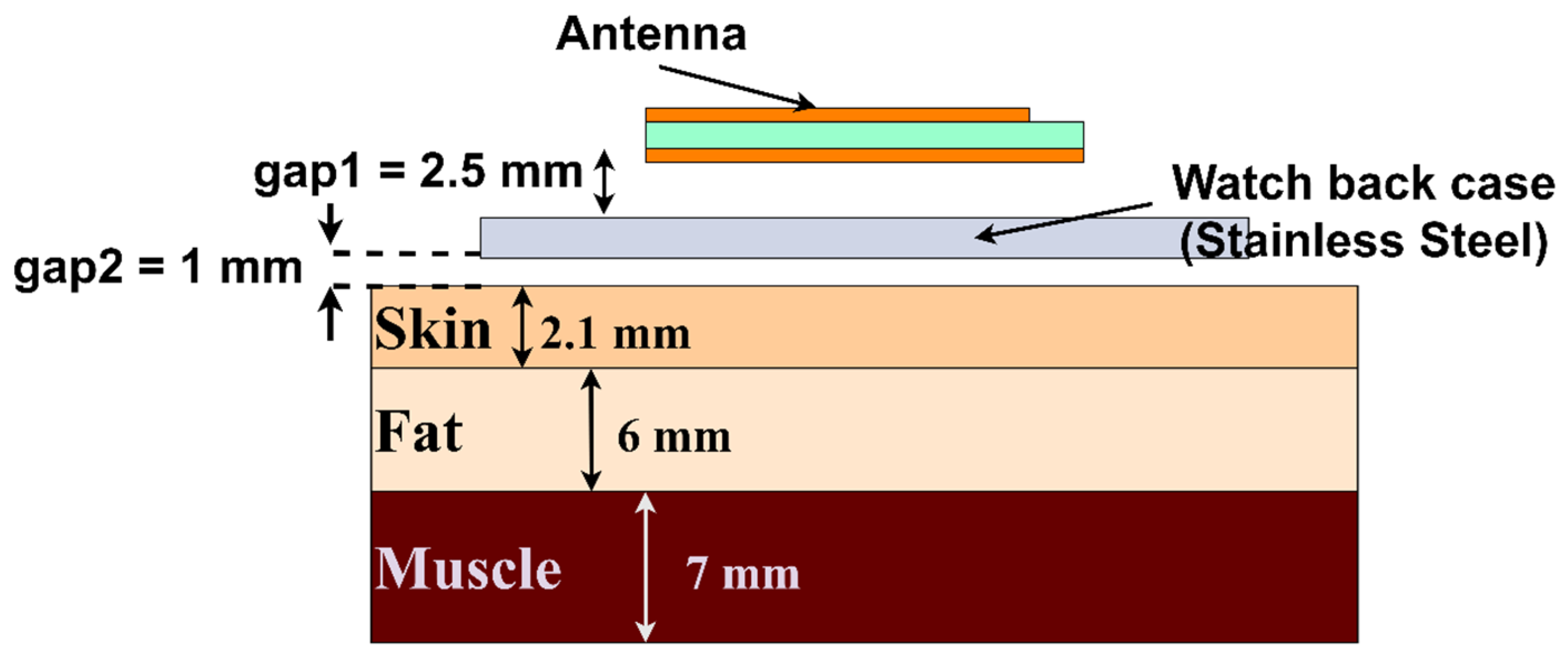


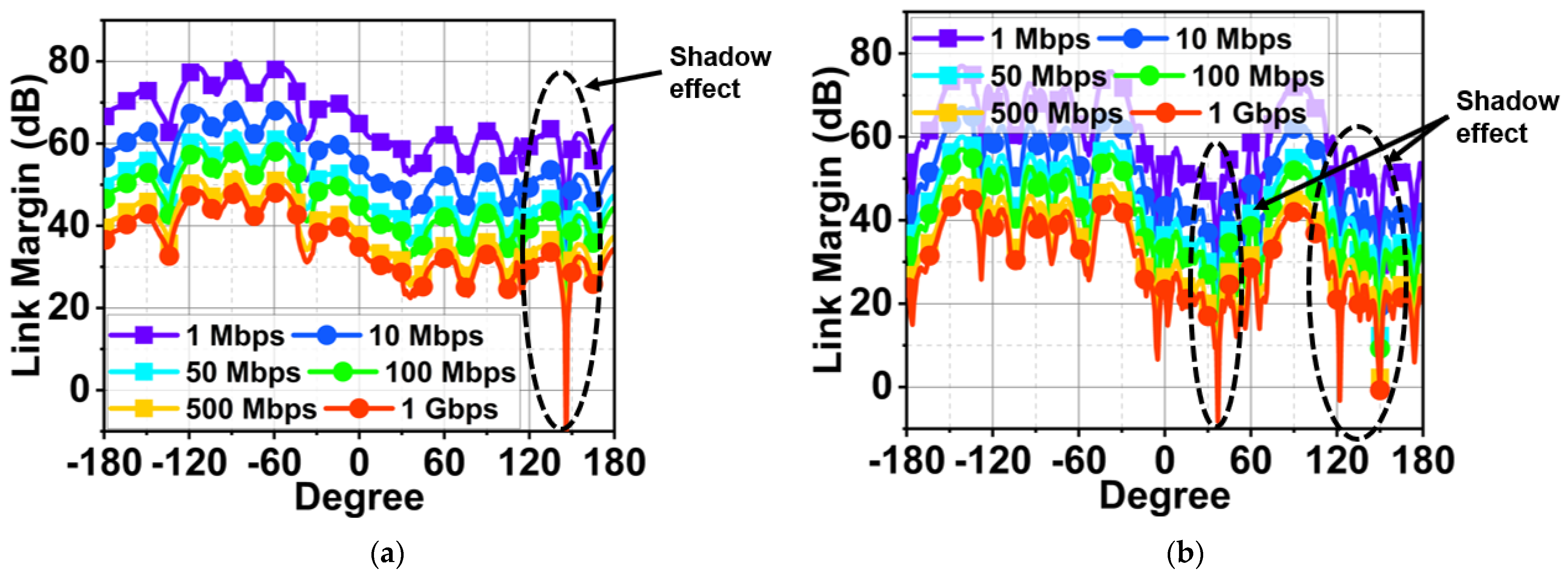
| 25.5 GHz | 38 GHz | ||||
|---|---|---|---|---|---|
| Tissue | Density (kg/m3) | Permittivity | Electrical Conductivity (s/m) | Permittivity | Electrical Conductivity (s/m) |
| Skin | 1109 | 18 | 24 | 12.3 | 31 |
| Fat | 911 | 6.34 | 4.66 | 5.33 | 6.36 |
| Muscle | 1090 | 26.2 | 31.1 | 19.1 | 41.8 |
| Ref | Ant Type | Dim (mm2) | Res (GHz) | BW (GHz) | Gain (dBi) | SA (W/kg) | Radiation | LM Analysis |
|---|---|---|---|---|---|---|---|---|
| [11] | Mono | 0.37λ0 × 27λ0 | 27/38/60 | 22–30/38–39.5/56–61 | 5.29/7.49/9 | 0.9/0.62/0.74 | Bi-Dir | No |
| [29] | Mono | 1.1λ0 × 0.86λ0 | 28.5/38 | 26–40.5 | 3.8 | NA | Bi-Dir | No |
| [30] | Mono | 2.41λ0 × 2λ0 | 60 | 58.2–60.5 | 9.9 | NA | Multi-Beam | No |
| [31] | Mono | 1.36λ0 × 1.22λ0 | 28/38 | 22–29/37–40 | 5 | NA | Omni | No |
| [32] | Mono | 0.75λ0 × 1.24λ0 | 37 | 36.7–37.4 | NA | NA | Broadside | No |
| [33] | Mono | 1.12λ0 × 1.12λ0 | 28/40 | 24–32/38–41 | 4.5 | NA | Bi-Dir | No |
| Proposed | Patch | 0.51λ0 × 0.51λ0 | 25.5/38 | 25–26.5/37–39.5 | 7.4/7.9 | 0.063/0.0206 | Broadside | Yes |
Disclaimer/Publisher’s Note: The statements, opinions and data contained in all publications are solely those of the individual author(s) and contributor(s) and not of MDPI and/or the editor(s). MDPI and/or the editor(s) disclaim responsibility for any injury to people or property resulting from any ideas, methods, instructions or products referred to in the content. |
© 2023 by the authors. Licensee MDPI, Basel, Switzerland. This article is an open access article distributed under the terms and conditions of the Creative Commons Attribution (CC BY) license (https://creativecommons.org/licenses/by/4.0/).
Share and Cite
Bhadrvathi Ghouse, P.S.; Mane, P.R.; Thankappan Sumangala, S.; Kumar Puttur, V.; Pathan, S.; Jhunjhunwala, V.K.; Ali, T. A Compact Dual-Band Millimeter Wave Antenna for Smartwatch and IoT Applications with Link Budget Estimation. Sensors 2024, 24, 103. https://doi.org/10.3390/s24010103
Bhadrvathi Ghouse PS, Mane PR, Thankappan Sumangala S, Kumar Puttur V, Pathan S, Jhunjhunwala VK, Ali T. A Compact Dual-Band Millimeter Wave Antenna for Smartwatch and IoT Applications with Link Budget Estimation. Sensors. 2024; 24(1):103. https://doi.org/10.3390/s24010103
Chicago/Turabian StyleBhadrvathi Ghouse, Parveez Shariff, Pallavi R. Mane, Sangeetha Thankappan Sumangala, Vasanth Kumar Puttur, Sameena Pathan, Vikash Kumar Jhunjhunwala, and Tanweer Ali. 2024. "A Compact Dual-Band Millimeter Wave Antenna for Smartwatch and IoT Applications with Link Budget Estimation" Sensors 24, no. 1: 103. https://doi.org/10.3390/s24010103
APA StyleBhadrvathi Ghouse, P. S., Mane, P. R., Thankappan Sumangala, S., Kumar Puttur, V., Pathan, S., Jhunjhunwala, V. K., & Ali, T. (2024). A Compact Dual-Band Millimeter Wave Antenna for Smartwatch and IoT Applications with Link Budget Estimation. Sensors, 24(1), 103. https://doi.org/10.3390/s24010103







